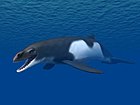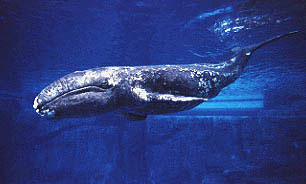
Eschrichtiidae or the gray whales is a family of baleen whale with a single extant species, the gray whale, as well as four described fossil genera: Archaeschrichtius (Miocene), Glaucobalaena and Eschrichtioides (Pliocene) from Italy, and Gricetoides from the Pliocene of North Carolina. Some phylogenetic studies have found this family to be invalid, with its members nesting inside of the clade Balaenopteridae. The names of the extant genus and the family honours Danish zoologist Daniel Eschricht.

Balaenoptera is a genus of rorquals containing eight extant species. Balaenoptera comprises all but two of the extant species in its family ; the genus is currently polyphyletic, with the two aforementioned species being phylogenetically nested within it.

Otodus megalodon, commonly known as megalodon, is an extinct species of giant mackerel shark that lived approximately 23 to 3.6 million years ago (Mya), from the Early Miocene to the Pliocene epochs. O. megalodon was formerly thought to be a member of the family Lamnidae and a close relative of the great white shark, but has been reclassified into the extinct family Otodontidae, which diverged from the great white shark during the Early Cretaceous.
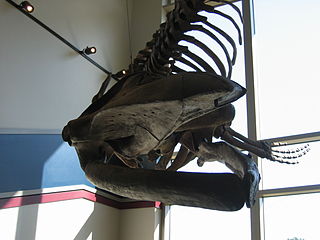
Eobalaenoptera is an extinct genus of baleen whale belonging to Balaenopteroidea.
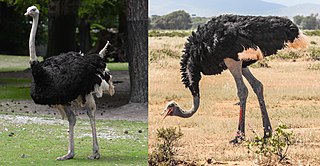
Ostriches are large flightless birds. Two living species are recognised, the common ostrich, native to large areas of sub-Saharan Africa, and the Somali ostrich, native to the Horn of Africa.
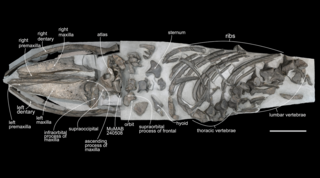
Plesiobalaenoptera is a genus of extinct rorqual which existed in Italy during the late Miocene epoch. The type species is P. quarantellii. It is the oldest known rorqual from the Mediterranean basin. Fossils have been found from sediments of the Stirone River in Northern Italy that were deposited during the Tortonian age, around 11 to 7 million years ago.
Diunatans is an extinct genus of rorqual. It lived in the North Sea during the Early Pliocene. Two specimens have been found from the Netherlands. They were collected from the Kattendijk Formation in the province of Zeeland, which is Zanclean in age. Diunatans is considered to be a stem balaenopterid because it falls outside the Balaenoptera+Megaptera clade, which includes all living rorquals.

Orcinus citoniensis is an extinct species of orca identified in the Late Pliocene of Italy and the Early Pleistocene of England. It was smaller than the modern killer whale, 4 m (13 ft) versus 7 to 10 m, and had around 8 more teeth in its jaw. It may have resembled the modern killer whale in appearance, and could represent a transitional species between the modern killer whale and other dolphins. O. citoniensis could have hunted fish and squid in pods, and coexisted with other large predators of the time such as the orcinine Hemisyntrachelus and the extinct shark Otodus megalodon.
Acer palaeorufinerve is an extinct maple species in the family Sapindaceae described from series of isolated fossil samaras and leaves. The species was described from Miocene to Pliocene aged fossils found in Japan and is known from Korean fossils and Miocene sediments exposed in the state of Alaska, USA. It is one of several extinct species placed in the living section Macrantha.
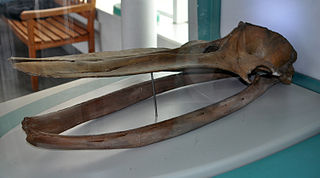
Piscobalaena is an extinct genus of cetaceans, which lived from the Middle to Late Miocene epochs in Peru and Florida. Its fossils have been found in the Pisco Formation of Peru and the Bone Valley Formation of Florida. At least some individuals of this diminutive whale were preyed on by the shark O. megalodon.
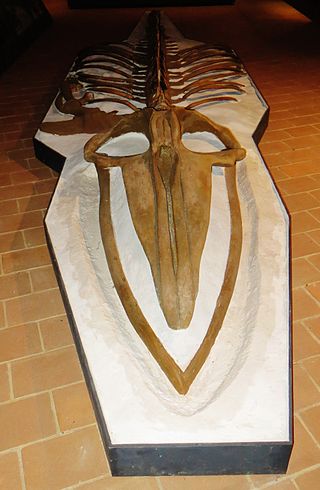
Protororqualus is a genus of extinct rorqual from the late Pliocene of Mount Pulgnasco, Italy.

Archaebalaenoptera is a genus of extinct rorqual known from late Miocene to Pliocene-age marine deposits of the Netherlands, Northern Italy, and Peru.
Plesiocetus is a genus of extinct rorquals found worldwide. It has had a chequered taxonomic history, having served as a wastebasket genus for a handful of mysticete species.

Eschrichtioides is an extinct genus of baleen whale known from the early Pliocene of Northern Italy. Its type species, E. gastaldii, had a complex taxonomic history, starting as a cetothere, then as an extinct member of Balaenoptera, before being finally recognized as a relative of the gray whale.
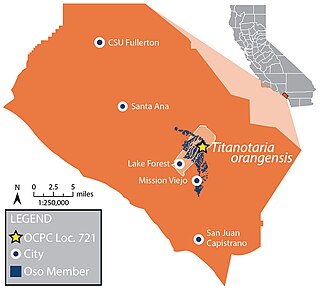
The Capistrano Formation is a geologic formation in coastal southern Orange County, California. It preserves fossils dating back to the late Miocene to early Pliocene, with the Oso Member representing a near-shore environment. Fifty-nine species and varieties of foraminifera are recognized from the Capistrano Formation alongside a diverse array of marine mammals including up to five species of walrus.

The Takikawa sea cow is an extinct herbivorous marine mammal of the Late Pliocene which was closely related to the recently extinct Steller's sea cow. In 1988, fossils of sea cows were discovered in Hokkaido and were originally assigned to the Takikawa sea cow, a newly described species, even though this taxon is thought of by some scientists as a synonym of the Cuesta sea cow. It is uncertain whether or not the Takikawa sea cow was simply a local variant of the Cuesta sea cow or a completely separate lineage. However, the Steller's sea cow and Takikawa sea cow share more morphological similarities than the Takikawa sea cow and Cuesta sea cow.

Balaenoptera siberi is an extinct species of baleen whale from the Late Miocene, described by Pilleri and Pilleri in 1989, based on fossils found in the Pisco Formation of the Pisco Basin in southwestern Peru.
Acer cascadense is an extinct maple species in the family Sapindaceae described from a series of isolated fossil samaras. The species is known from fossils found in Middle Miocene deposits of central Oregon. It is one of several extinct species placed in the living Acer section Negundo.















